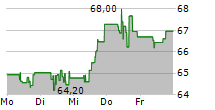
NORTHAMPTON, MA / ACCESSWIRE / March 6, 2024 / Wells Fargo
With initial support from the Wells Fargo Foundation, new focus area will bring evidence-based research to the intersections between housing and climate policy
Author: Carolina Reid
In the face of a rapidly changing climate, the intersection of housing and climate policy has emerged as a critical area of focus. The policies that impact where and what type of housing and communities are built are inextricably linked to environmental sustainability and resilience. These issues are not separate from the affordability crisis that dominates much of the housing policy discussion. Indeed, the lack of affordable housing has many adverse impacts for the climate, including pushing new housing into the wildland-urban interface and increasing the time people spend in their cars. In turn, climate-related disasters exacerbate the housing crisis by reducing the supply of affordable housing and increasing costs, such as home insurance.
Since its founding, the Terner Center's mission has been to formulate bold strategies to house families from all walks of life in vibrant, sustainable, and affordable homes and communities. We have pursued this mission by focusing our research on issues such as land use and zoning reforms that unlock new supply, racial gaps in access to homeownership, improving the way we finance and provide affordable housing, and addressing homelessness.
While mitigating and building resilience to climate change was always a part of this original mission, we have done less research on the intersections between housing and climate than we had initially planned. However, the growing threat of climate change is increasing the urgency for solutions, and specifically, solutions that don't run counter to the urgency of the housing crisis and the ongoing efforts to expand housing supply. We're excited to share that, with initial support from the Wells Fargo Foundation, we are launching a new focus area that will bring evidence-based research to the intersections between housing and climate policy.
Some of the challenges motivating our work on climate are not far afield from the housing policy failures we have tackled (and will continue to address). For example, the predominance of single-family zoning in the United States has exacerbated both affordability and the climate crises.1 Our goal of pursuing solutions that advance social and racial equity are strongly aligned with a focus on climate: the consequences of both housing and climate policy failures fall disproportionately on people with low incomes and people of color. Not only are these households more vulnerable to climate disasters due to where they live and the conditions of the homes they can afford,2 they are also less likely to receive disaster recovery assistance.3 These households are likewise more vulnerable to chronic stressors exacerbated by climate change, such as heat and air pollution.4
But there is also the real risk that in the effort to respond to climate change, policy makers may make decisions that run counter to housing affordability and equity goals, when in fact what is needed are policies that advance progress on both fronts. Fragmented governance at the local, state, and federal scales contributes to poorly coordinated policies across housing and climate areas,5 which hamper their effectiveness and further pit climate and affordability goals in opposition to one another.
Research is needed to provide policy makers with better evidence to navigate these tensions between climate and housing policies, and to identify complementary solutions at all scales of government. For example:
- To what extent does building infill housing in cities contribute to reducing emissions in their corresponding metropolitan regions? Can greater suburban housing density also be part of the solution set?
- How can the existing housing stock be retrofitted to improve energy efficiency and eliminate reliance on fossil fuels, while at the same time ensuring that these efforts don't raise energy cost burdens or displace renters of color and low-income renters?
- How could federal climate disaster assistance programs be better designed to protect renters and people experiencing homelessness, while not losing sight of the need to address long-term housing inequities?
Our new "Housing + Climate" research area explores these topics and contributes to efforts to better align housing and climate policies. We've already started: we have launched new research projects that will explore how California's housing policies can best advance its greenhouse gas emission reduction targets. We are working with a coalition of community-based and environmental justice groups to better understand what is needed to advance equitable housing decarbonization strategies. We're also looking at how federal Greenhouse Gas Reduction Fund grants can be leveraged to fund retrofitting and decarbonization of affordable housing. In 2024, our sister nonprofit, Terner Labs, is launching a new Builders Lab initiative, which will provide an opportunity to incubate innovative construction techniques and identify strategies to overcome regulatory and other barriers to implementation.
Neither the climate nor the housing crises are easy challenges to address: both are emblematic of "wicked problems"6-complicated, evolving, and multiscalar-without simple answers but with high stakes if we get the answers wrong. Research can help guide necessary policies, but partnerships and collective action are similarly critical.
We invite your input as we undertake this work. Find our first report in our Housing + Climate research area, which is a review of the research on links between housing and climate in the U.S. on our website here.
Footnotes:
- McCabe, B. (2016). No Place Like Home: Wealth, Community, and the Politics of Homeownership. Oxford University Press; Manville, M., Monkkonen, P., & Lens, M. (2020). "It's Time to End Single-Family Zoning." Journal of the American Planning Association 86, no. 1: 106-12, https://doi.org/10.1080/01944363.2019.1651216; Dougherty, C. (2020). Golden Gates: Fighting for Housing in America. New York: Penguin Press; Trounstine, J. (2018). Segregation by Design: Local Politics and Inequality in American Cities. New York: Cambridge University Press; Volker, J., Lee, A., & Fitch, D. (2019). "Streamlining the Development Approval Process in a Post-Level of Service Los Angeles," Journal of the American Planning Association 85, no. 2: 114-32, https://doi.org/10.1080/01944363.2019.1601587.
- Tonn, B., et al. (2021). "A Futures Perspective of Health, Climate Change and Poverty in the United States." Futures 131: 102759, https://doi.org/10.1016/j.futures.2021.102759; U.S. Department of Housing and Urban Development. (2022). "The Role of Housing in Climate Change Mitigation and Adaptation." Evidence Matters, https://www.huduser.gov/portal/periodicals/em/Summer22/highlight1.html; Shi, L., et al. (2016). "Roadmap towards Justice in Urban Climate Adaptation Research." Nature Climate Change 6, no. 2: 131-37, https://doi.org/10.1038/nclimate2841.
- Ma, C. & Culhane, D. (2022). "Addressing Low-Income Household Sheltering Needs after a Disaster: A Needs Assessment among Hurricane Harvey Housing Victims." Housing Studies 0, no. 0 (2022): 1-16, https://doi.org/10.1080/02673037.2022.2149704; Rivera, D., Jenkins, B., & Randolph, R. (2022). "Procedural Vulnerability and Its Effects on Equitable Post-Disaster Recovery in Low-Income Communities." Journal of the American Planning Association 88, no. 2: 220-31, https://doi.org/10.1080/01944363.2021.1929417; Comerio, M. (2014). "Disaster Recovery and Community Renewal: Housing Approaches," Cityscape 16, no. 2: 51-68; Martín, C. (2022). "Housing After Disasters and the Importance of Comprehensive and Equitable Recovery Policies." Joint Center for Housing Studies, Harvard University. Retrieved from: https://www.jchs.harvard.edu/blog/housing-after-disasters-and-importance-comprehensive-and-equitable-recovery-policies.
- Chu, E.K., et. al. (2023). "Ch. 12. Built environment, urban systems, and cities." In: Fifth National Climate Assessment. Crimmins, A.R., et. al., Eds. U.S. Global Change Research Program, Washington, DC, U.S.A. https://doi.org/10.7930/NCA5.2023.CH12.
- Martín, C. (2022). "Exploring Climate Change in U.S. Housing Policy," Housing Policy Debate 32, no. 1: 1-13, https://doi.org/10.1080/10511482.2022.2012030.
- Rittel, H. W., & Webber, M. M. (1973). "Dilemmas in a General Theory of Planning." Policy sciences, 4(2), 155-169. https://www.cc.gatech.edu/fac/ellendo/rittel/rittel-dilemma.pdf.
View additional multimedia and more ESG storytelling from Wells Fargo on 3blmedia.com.
Contact Info:
Spokesperson: Wells Fargo
Website: https://www.3blmedia.com/profiles/wells-fargo
Email: info@3blmedia.com
SOURCE: Wells Fargo
View the original press release on accesswire.com




